To relieve back pain during pregnancy, the pregnant woman can lie on her stomach with her knees bent and arms stretched out along her body, keeping the whole spine well settled on the floor or on a firm mattress. This position accommodates the vertebrae well, removing the weight from the back, thus relieving the back pain in a few minutes.
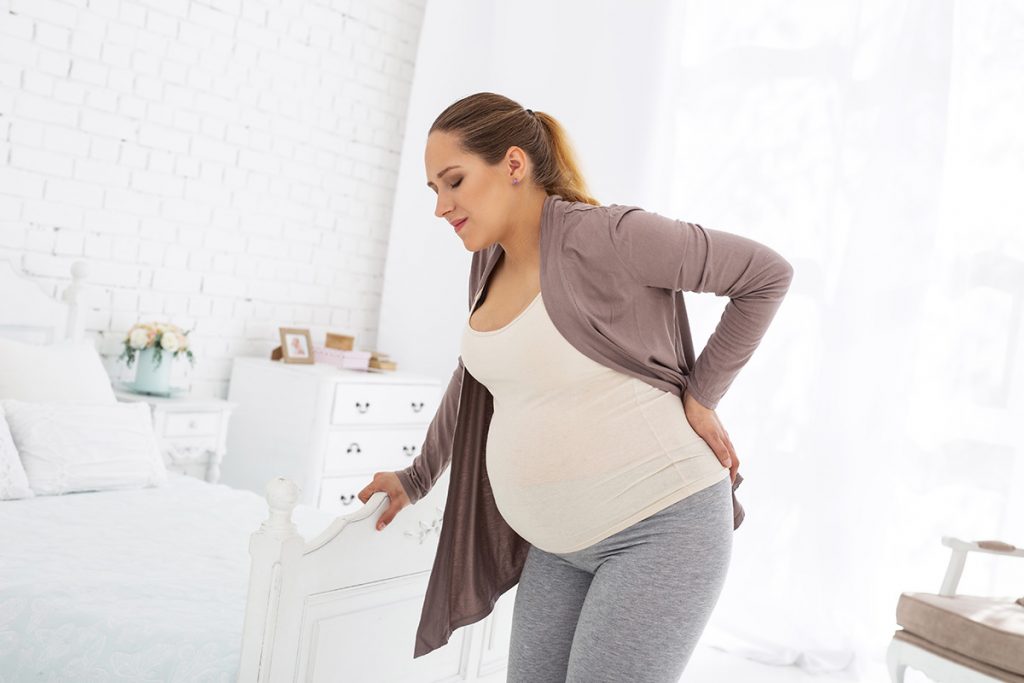
Back pain is a common situation that occurs in 7 out of 10 pregnant women, and especially affects teenagers, who are still growing, women who smoke and those who have already presented a picture of back pain before becoming pregnant.
Who is more likely to have back pain during pregnancy?
Women with a history of previous lower back pain are at higher risk, and may have had crises without being pregnant, or in previous pregnancies.
You also present a higher risk if you have a very sedentary life and have flexibility and shortening in the lower back, and weakness in the back and abdominal muscles.
Women pregnant with twins are also more likely to have back pain. Obesity can be a risk factor for the development of lower back pain during pregnancy, but the results of studies are conflicting.
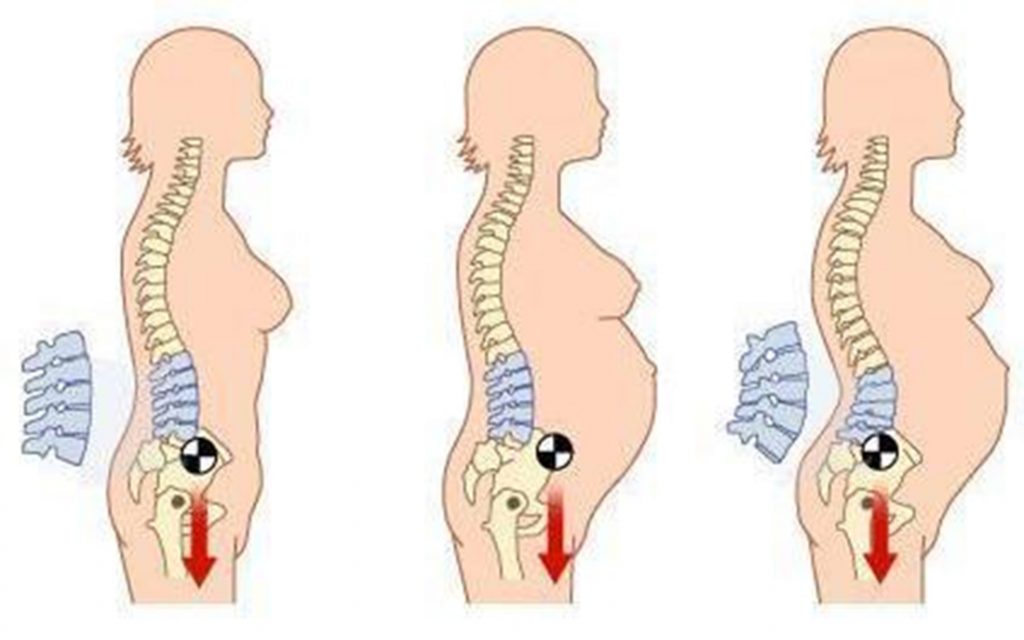
What to do to fight back pain in pregnancy
The best strategies to eliminate back pain in pregnancy are:
1. Use hot compress: taking a hot bath, directing the water jet from the shower to the area where it hurts or applying a hot water bag to the back is a good way to relieve the pain. In addition, warm compresses with basil or eucalyptus essential oil over the affected area for 15 minutes 3 to 4 times a day can also help;
2. Using pillows between the legs to sleep on the side, or under the knees when sleeping face up also helps to accommodate the spine better, reducing discomfort;
3. Massage: back and leg massage can be done with oil daily to relieve muscle tension. See the benefits and contraindications of massage in pregnancy.
4. Do stretching: Lie on your stomach with legs bent, holding only one leg at a time, positioning your hands behind your thighs. With this movement the lumbar spine is rectified bringing immediate relief from back pain. This stretching should be maintained for at least 1 minute at a time, controlling the breathing well.
5. Do physiotherapy: there are different techniques that can be used, such as kinesio tape, vertebral manipulation, pompage and others that can be used by the physiotherapist according to need;
6. Use medicines: In some cases, it may be necessary to pass an anti-inflammatory ointment such as Cataflan, and in these cases, you should consult the doctor before its use. Taking oral medications such as Dipyrone and Paracetamol is a possibility for times when the pain is more intense, but it is not indicated to take more than 1g per day for more than 5 days. ATTENTION: For the use of any medicine the doctor must be consulted.
7. Practicing exercises regularly: Good options are hydrokinesiotherapy, swimming, Yôga, Clinical Pilates, but the daily walk, for about 30 minutes also has great results in pain relief.
Is it normal to have back pain early in pregnancy?
It is very common for a pregnant woman to start feeling back pain early in pregnancy due to increased progesterone and relaxation in the bloodstream, which makes the ligaments of the spine and sacrum loosen, which promotes pain, which can be in the middle of the back or at the end of the spine.
The presence of back pain before pregnancy also increases the chances of the woman suffering from this symptom during pregnancy, as early as the first trimester, and in some women the pain gradually increases as the pregnancy progresses.
How to avoid back pain during pregnancy
To avoid back pain in pregnancy it is important to be at the right weight before getting pregnant. It is also important:
– Do not put on more than 10 kg during every pregnancy;
– Wear a support strap for pregnant women when the belly starts to weigh;
– Do leg and back stretching exercises every morning and evening. Learn how to do it on: Stretching exercises in pregnancy;
– Always keep your back straight, sitting and walking.
– Avoid lifting weights, but in case you have to, hold the object close to your body, bending your knees and keeping your back straight;
– Avoid wearing high heels and low-cut sandals, preferring shoes 3 cm high, comfortable and firm.
Basically the back pain in pregnancy happens because the lumbar region accentuates its curvature with the frontal uterine growth, which in turn changes the position of the sacrum, which becomes more horizontal in relation to the pelvis. Similarly, the thoracic region also has to adapt to the growth in breast volume and changes in the lumbar region, and reacts to these changes by increasing the dorsal kyphosis. The result of these changes is back pain.
What can cause back pain in pregnancy
Back pain in pregnancy is usually caused by muscle and ligament changes. This pain almost always worsens when the pregnant woman stands or sits for a long time, when she picks something up from the ground improperly, or has very stressful activities that cause a lot of tiredness.
Some situations that can aggravate this symptom are domestic or professional activities, repetitive effort, having to stand for many hours or sitting for many hours. The younger the pregnant woman is, the greater the chances are that she will have back pain from the beginning of the pregnancy.
Another cause of back pain in pregnancy is sciatica, which is very strong, which seems to ‘pinch one of the legs’, making it difficult to walk and remain seated, or which is accompanied by a hooked or burned feeling. In addition, at the end of pregnancy, after 37 weeks of pregnancy, uterine contractions can also manifest as back pain that appears rhythmically and only relieve after the birth of the baby.
When to go to the doctor
Back pain in pregnancy is not always dangerous, but the pregnant woman should go to the doctor if the back pain remains even after all the ways to relieve it or when it is so intense that it prevents her from sleeping or performing her daily activities. In addition, you should see your doctor when back pain suddenly appears or is accompanied by other symptoms, such as nausea or shortness of breath.
Lower back pain in pregnancy should not be ignored because it is harmful to your health, and impairs your sleep, your disposition for daily life, reduces your performance at work, social life, domestic activities and leisure, and can also cause financial problems due to being away from work.
SEE ALSO: How to avoid Stretch Marks, Spots and Varicose Veins in Pregnancy
11 tips for dealing with back pain in pregnancy!
It is estimated that about 70% of pregnant women will have back pain at some point in their pregnancy. The pain is mostly due to the pregnancy’s hormonal changes and the growth of the uterus that leave the abdominal muscles weaker, overloading the spine. The pain usually appears in the second and third trimesters of pregnancy and causes great discomfort to sleep or walk.
Back pain poses no risk to the baby and some simple everyday measures can help reduce the problem without the use of medication. However, if the pain is very severe and incapacitating, be sure to consult your doctor for advice on the use of pain medication, if necessary, or refer you to the physiotherapy service.
Check out some tips to relieve back pain in pregnancy:
Keep the appropriate weight
Overweight is one of the main reasons for overloading the spine, which results in pain in the lumbar region. Ideally, before even impregnating a woman, she should be at the right weight. But if you are already pregnant, maintain a balanced and healthy diet to avoid overweight gain and also to take better care of yourself and your baby.
In a simple pregnancy, with a single fetus, the expectation is that the woman who was at her normal weight before getting pregnant will put on 11.5 to 16 kilos by the end of the pregnancy. If you were overweight you could gain 7 to 11.5 kilos. In cases of obesity before pregnancy, it is recommended that the weight gain be between 5 and 9 kilos.
Do stretches
Stretching at the beginning and end of the day helps a lot to decompress the spine and relieve pain and is very simple to do.
Lie down on a firm surface (it can be on the floor or on a mattress), bend your legs supporting the whole lumbar region well and keep your arms at your side. Stay in this position for a few minutes until you feel the relief of the vertebrae. Then raise one leg by bending the knees. Hold the leg to the back of the thigh. Hold the position for one minute with each leg, keeping your breathing steady.
Stretching exercises in pregnancy
Stretching exercises are very beneficial in pregnancy as they help relieve back pain, increase blood circulation by decreasing swelling in the legs, and are also useful for bringing more oxygen to the baby, helping it grow healthier.
In addition, a stretching class also helps to combat constipation and relieve gases, which are very common during pregnancy. Stretching also prevents muscle injuries and pain and helps the woman prepare for labour.
Below we indicate 3 stretching exercises, which can be done at home, to relieve back pain during pregnancy:
Exercise 1
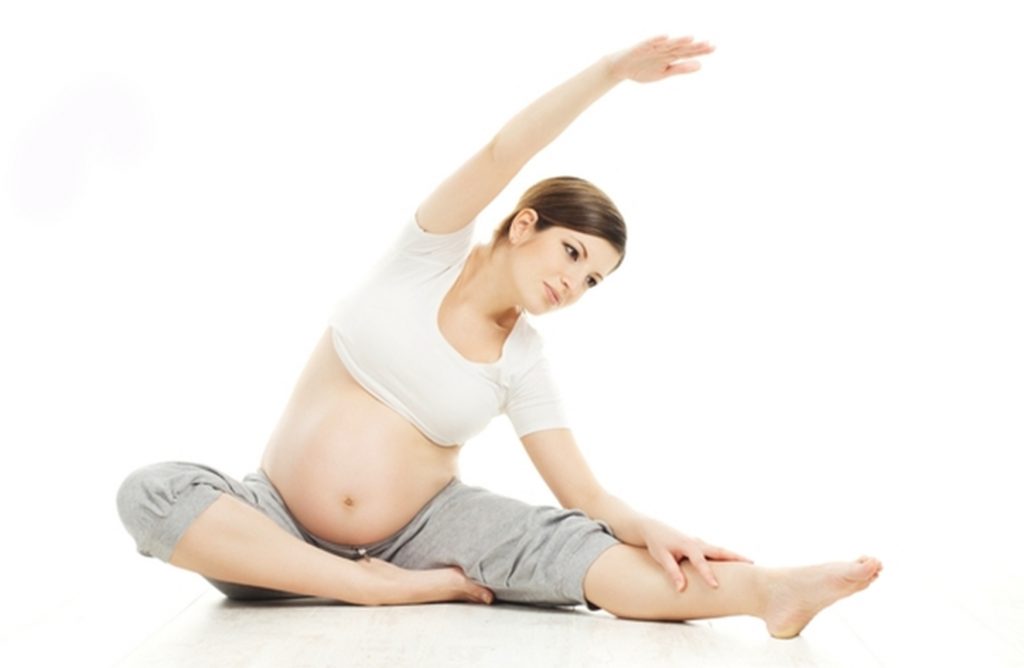
Sitting with the legs apart, bend one leg placing the foot in contact with the other thigh and lean the body to the side, as shown in the image, feeling stretching all around for 30 seconds. Then change the leg and do the exercise to the other side.
Exercise 2

Remain in the position shown in image 2 for 30 seconds so that you feel your back stretch.
Exercise 3
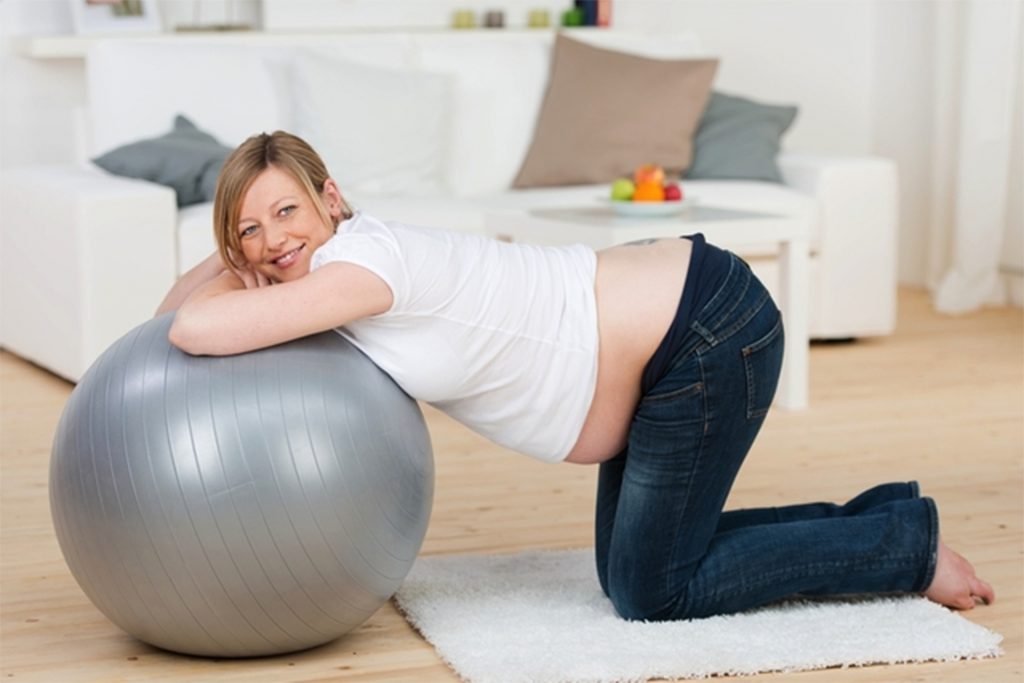
With your knees resting on the ground, lean over a Pilates ball, trying to keep your back straight. You can stretch your arms on top of the ball and try to support your chin on your chest at the same time. Stay in that position for 30 seconds.
When performing the stretching exercises, the pregnant woman should breathe slowly and deeply, inhaling through her nose and breathing out through her mouth. The stretching exercises in pregnancy can be done every day and repeated between 2-3 times, with intervals of 30 seconds between each one.
Although it is rare, back pain that does not relieve with rest, and that remains constant during the day and night can indicate something more serious and therefore this is a symptom that should not be ignored.
Get physical exercise
If there is no medical contraindication, include a light exercise in your routine. It can be a walk, yoga, pilates, swimming or hydrogymnastics. In addition to helping you keep your weight, the practice of exercises will strengthen your muscles, avoiding back pain.
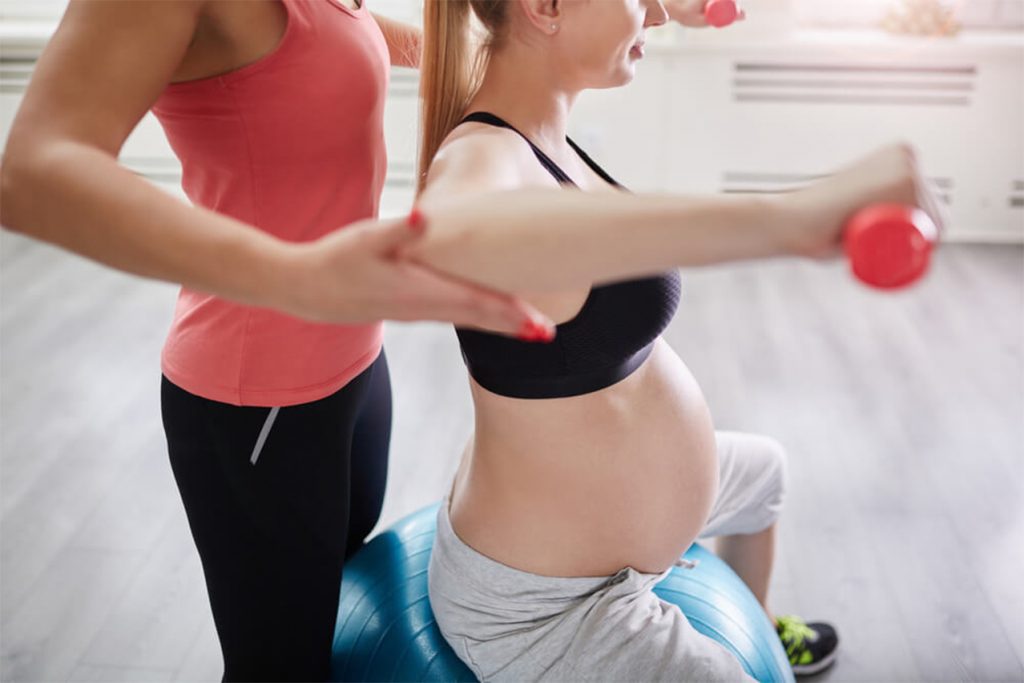
In addition to the exercises that can be done at home, the pregnant woman can also do stretches in hydrogymnastics classes, which also contribute to reducing joint stress and muscle discomfort. It is recommended that hydrogymnastics be performed two to three times a week, lasting about 40 minutes to one hour, with a light to moderate intensity.
Pilates is also a good option because it helps to stretch and relax the muscles, preparing the muscles of the perineum region for delivery and postpartum, stimulates circulation, develops breathing techniques and posture correction.
Use hot water compresses
Another way to relieve back pain during pregnancy is the use of hot water compresses at the site of pain. You can use a thermal bag or wet towel, always taking care to check the temperature so as not to cause burns and skin irritation.
A warm bath, letting the water fall on top of the most critical spot also helps with relief. The warmth relaxes the muscles, reducing the sensation of pain.
Take massages
Back and leg massages are also very effective for relieving back pain. The goal is the same as using hot water: to relax and take the tension out of the muscles.
The use of a massage oil can make the moment even more pleasant for you and your partner. Professional massages with a physiotherapist or masseur are also very welcome.
Use pillows to stabilize your spine
Putting a pillow between your legs to sleep on your side or under your knees when you lie on your stomach will also help with pain relief.
There are some body pillow models on the market that help to keep the whole spine stabilized during sleep, avoiding the overload of the lumbar region and consequently the back pain.
Wear comfortable and anatomical shoes
One of the changes brought about by pregnancy is the change in the centre of balance, which leaves not only the spine more overloaded, but also the knees and ankle joints. Therefore, it is important to keep an eye on the model of the shoe that is worn during this period.
Avoid high heels, which require greater balance, as they overload the heels. Opt for comfortable and anatomical shoes, with about three centimeters of heel (maximum) and that leave the feet well attached.
Wear belly straps
A very useful accessory for relieving back pain in pregnancy is the support belt. It helps to better distribute the weight of the belly by reducing the pressure on the abdominal and back muscles. Talk to your doctor so that he can indicate the best model.
Avoid lifting weights
Avoid carrying bags or very heavy objects. If necessary, take them close to your body to avoid arching your spine. If you have to lift them from the ground, bend your knees and not your back.
Keep a good posture
If you spend too much time sitting down, try to keep your back straight and steady. Use a stool to support your feet and maintain the correct knee angulation. Get up every hour or hour and a half to stretch your legs and encourage circulation.
If you are standing for a long time, it is also important to pause periodically to move and rest your legs and spine.
Identify the type of back pain in pregnancy
As we said, most back pain in pregnancy will be from muscle weakness. But in some women, though rare, back pain can be contractions, without the belly getting hard. Note if the back pain happens in waves and if it is rhythmic – mark the time between one wave and another on the watch. If you feel these pains before the 37th week, you may be having premature contractions. Be sure to tell your doctor to evaluate it.
Some pregnant women may also have sciatica, which is stronger and occurs at the base of the back, and can cause tingling or numbness in the legs. It happens because of pressure or inflammation of the sciatic nerve. Try to identify the position that causes the pain and avoid it. If the pain persists, seek medical advice.
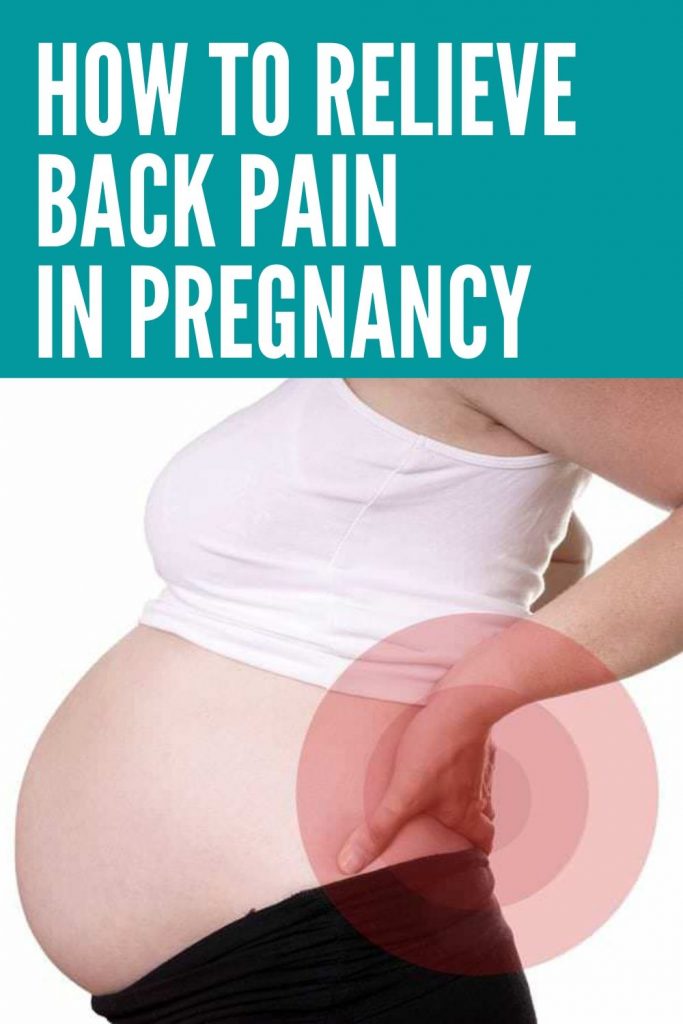
HashTags: #backpainduringpregnancy #backpainreliefduringpregnancy #backpainpregnancy #lowerbackpainpregnancy #relievingbackpainduringpregnancy #backacheduringpregnancy #pregnancybackpain #howtorelievebackpainduringpregnancy #backpainearlypregnancy #pregnancybackpainrelief #lowerbackpainduringpregnancy #ptforbackpainduringpregnancy #backpainduringearlypregnancy #managingbackpainduringpregnancy #pregnancyexercises #pregnancystretchesforbackpain #pregnancyexercise #pregnancybackpainexercises #exercisesforpregnancybackpain #pregnancyexercisesforbackpain #pregnancylowerbackpainexercises


